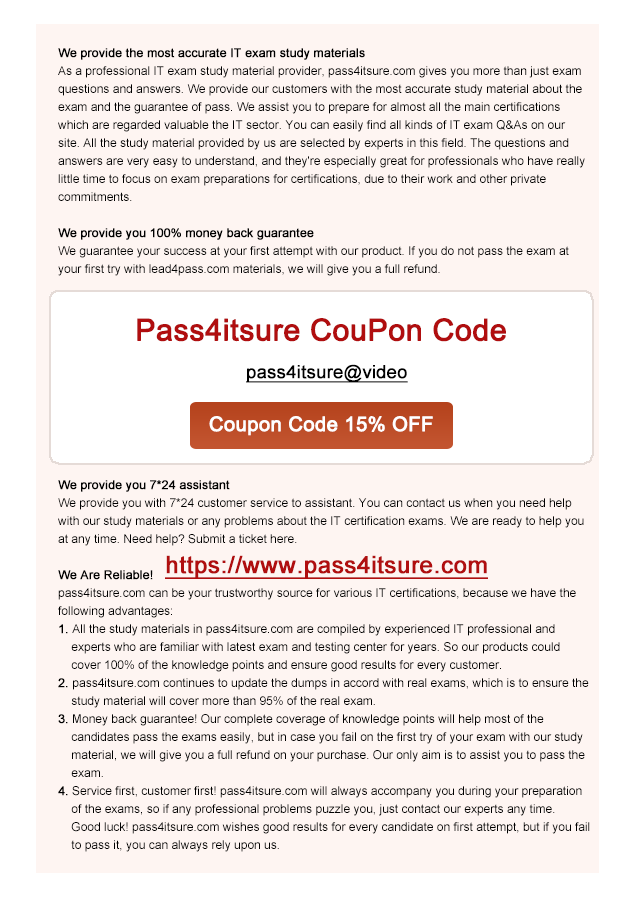What is latest version of 70-357 dumps certification? Microsoft 70-357 certification exam is the best way to update your knowledge and skills in MCSD field. Candidates can prepare for pass4itsure 70-357 dumps pdf exam by taking the course, “Developing Mobile Apps”. Developing Mobile Apps is the exam name of 70-357 Visual Studio test that the computer-based, multiple-choice exam tests the candidate’s knowledge with the Model-View-ViewModel (MVVM) design pattern and Entity Framework, along with authentication technologies. Visual Studio 2015 experience is highly recommended.
A lot of companies are offering cheap 70-357 dumps for Developing Mobile Apps exam but with little to no good results. stumbling on this stage, you will find out the ways of passing the MCSD 70-357 test questions on the first try. Here you can download free practice tests 70-357 Visual Studio: Developing Mobile Apps. Not only has this but Developing Mobile Apps exam also makes you sure about progress in IT field. Again if you want to get inspiring jobs in IT enterprises, the Visual Studio Community 70-357 dumps certification exam is the ultimate solution. The Developing Mobile Apps (70-357 Visual Studio) exam is a 52q question assessment that is associated with the MCP, MCSA certification.
- Exam Code: 70-357
- Exam Name: Developing Mobile Apps
- Q&As: 50
- Instant Download After Purchase
- 100% Money Back Guarantee
- 365 Days Free Update
- 7000+ Satisfied Customer
Latest and Most Accurate Pass4itsure 70-357 Dumps Exam Q&As(10-18)
Question No : 10 HOTSPOT – (Topic 2)
You have an app that includes the following method:

For each of the following statements, select Yes if the statement is true. Otherwise, select No.

Box 1: No
When neither DesiredAccuracyInMeters nor DesiredAccuracy are set, your app will use an accuracy setting of 500 meters (which corresponds to the DesiredAccuracy setting of Default). Setting DesiredAccuracy to Default or High indirectly sets DesiredAccuracyInMeters to 500 or 10 meters, respectively.
Box 2: No
The Default value should be used to optimize for power, performance, and other cost considerations. The High value should be used to deliver the most accurate report possible. This includes using services that might charge money, or consuming higher levels of battery power or connection bandwidth. An accuracy level of High may degrade system performance and should be used only when necessary.
Question No : 11 – (Topic 2)
You must create a control that meets the following requirements:
• allows you to extend the behavior of a combo box allows the arrow image is located at the right edge of a standard control to be replaced with a new image
• has a property that sets and returns the image
•has a visual interface of the control that is defined by using XAML
•defines the properties for the control in code
You need to create the control.
Which object should you use?
A. ContentDialog
B. StaticResource
C. ThemeResource
D. UserControl
70-357 exam Answer: A
Explanation:
ContentDialog represents a dialog box that can be customized to contain checkboxes, hyperlinks, buttons and any other XAML content.
Question No : 12 HOTSPOT – (Topic 2)
You are developing a Universal Windows Platform (UWP) app that processes and displays data from your company’s personnel database. Users report that one of the views in the UWP app loads slowly. You need to optimize the load time. How should you complete the relevant markup? To answer, select the appropriate markup segment from each list in the answer area.
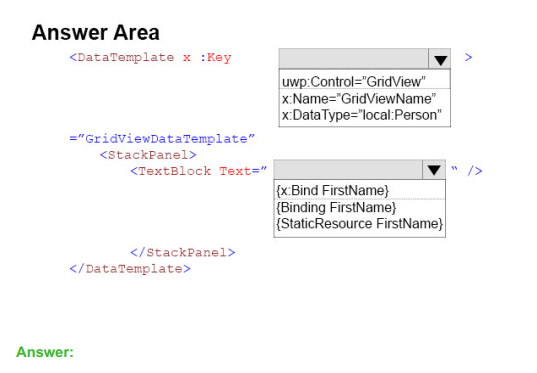
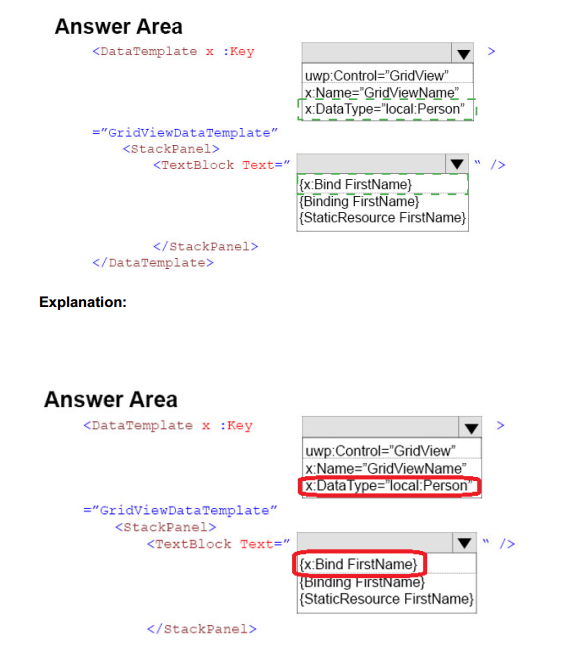
The {x:Bind} markup extension—new for Windows 10—is an alternative to {Binding}. {x:Bind} lacks some of the features of {Binding}, but it runs in less time and less memory than {Binding} and supports better debugging. In the following example, the background and foreground of the item are bound to functions
to do conversion based on the color parameter
<DataTemplate x:DataType=”local:ColorEntry”>
<Grid Background=”{x:Bind Brushify(Color)}” Width=”240″>
<TextBlock Text=”{x:Bind ColorName}” Foreground=”{x:Bind TextColor(Color)}”
Margin=”10,5″ />
</Grid>
</DataTemplate>
Question No : 13 HOTSPOT – (Topic 2)
You are developing a Universal Windows Platform (UWP) app. The app does not display content properly on mobile devices. You need to support smaller window sizes. How should you complete the relevant XAML markup? To answer, select the appropriate markup segment from each list in the answer area.
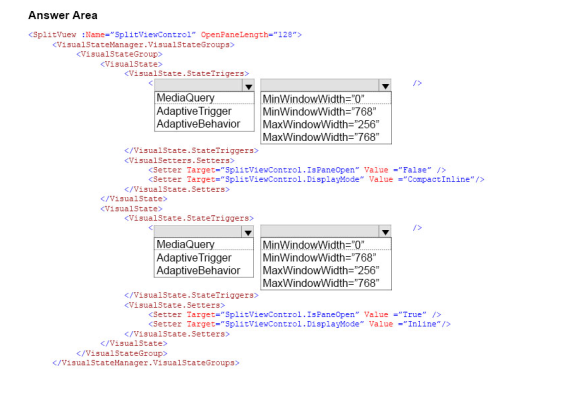
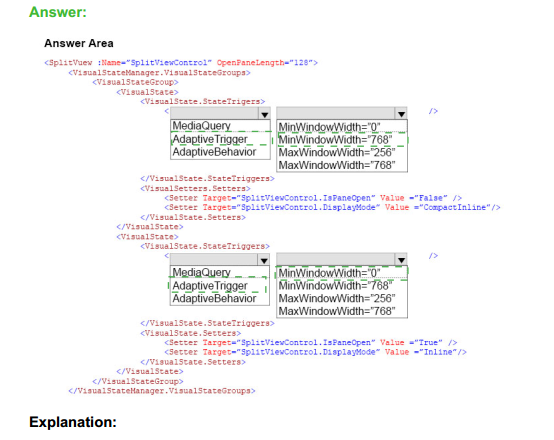
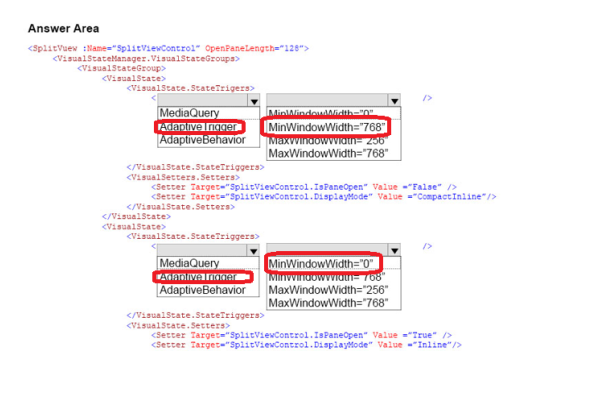
One of the tools that Microsoft gives us for building adaptive UIs in UWP apps is state triggers. The version of Windows 10 released at BUILD 2015 features one state trigger: a class named AdaptiveTrigger. AdaptiveTrigger has two important properties: MinWindowWidth and MinWindowHeight. You use AdaptiveTrigger in conjunction with Visual State Manager to adapt the UI to screens and windows of various sizes.
* Inline
The pane is always visible and doesn’t overlay the content area. The pane and content areas divide the available screen real estate.
* CompactInline
A narrow portion of the pane is always visible in this mode, which is just wide enough to show icons. The default closed pane width is 48px, which can be modified with CompactPaneLength. If the pane is opened, it will reduce the space available for content, pushing the content out of its way.
Question No : 14 DRAG DROP – (Topic 2)
You are developing a Universal Windows Platform (UWP) a pp. The app has the following requirements:
. Users must be able to authenticate with the app by using a third-party OAuth provider.
. Users must have the option of using Single Sign-On.
You obtain the security identifier (SID) for the app from the Windows Dev Center. You need to implement authentication for the app. In which order should you perform the actions? To answer, move all actions from the list of actions to the answer area and arrange them in the correct order.
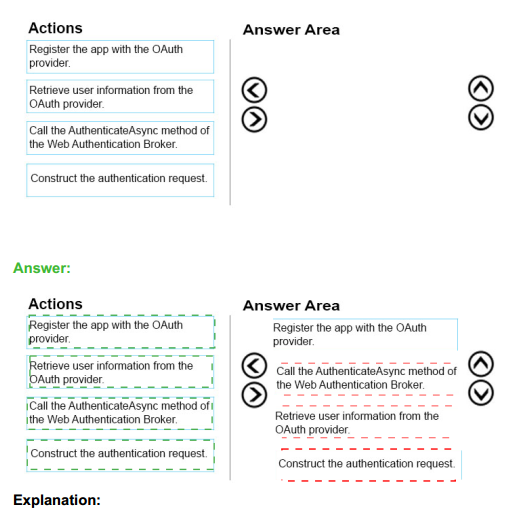
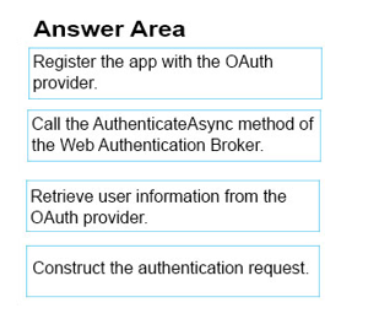
Step 1: Register your app with your online provider
You must register your app with the online identity provider to which you want to connect. You can find out how to register your app from the identity provider. After registering, the online provider typically gives you an Id or secret key for your app.
Step 2: Build the authentication request URI
The request URI consists of the address where you send the authentication request to your online provider appended with other required information, such as an app ID or secret, a redirect URI where the user is sent after completing authentication, and the expected response type. You can find out from your provider what parameters are required.
Step 3-4: Connect to the online provider
You call the AuthenticateAsync method to connect to the online identity provider and get an access token. The method takes the URI constructed in the previous step as the requestUri parameter, and a URI to which you want the user to be redirected as the callbackUri parameter.
Note: Step 5: Connecting with single sign-on (SSO).
By default, Web authentication broker does not allow cookies to persist. Because of this, even if the app user indicates that they want to stay logged in (for example, by selecting a check box in the provider’s login dialog), they will have to login each time they want to access resources for that provider. To login with SSO, your online identity provider must have enabled SSO for Web authentication broker, and your app must call the overload of AuthenticateAsync that does not take a callbackUri parameter. This will allow persisted cookies to be stored by the web authentication broker, so that future authentication calls by the same app will not require repeated sign-in by the user (the user is effectively “logged in” until the access token expires).
Question No : 15 – (Topic 2)
Note: This question it part of a series of questions that present the same scenario. Each question in the series contains a unique solution. Determine whether the solution meets the stated goals. You are developing a Universal Windows Platform (UWP) app. Your app stores files on a user’s device. You need to be able to replace the existing files with new files generated by the user. Solution you run the StoragaFile.GetParentAsync method to get a reference to the existing file. Then, you run the StorageFile.CreateStreamedFileAsyne method to create the- new file at that same location. Does this meet the goal?
A. yes
B. No
70-357 dumps Answer: A
Explanation: The GetParentAsync() method gets the parent folder of the current file.
The CreateStreamedFileAsync method can be used to create a StorageFile that can be
passed to other methods or passed to another app through app contracts.
Question No : 16 HOTSPOT – (Topic 2)
You are developing a Universal Windows Platform (UWP) app. You need to implement responsive user design patterns. Which of the following techniques are supported? To answer, select the appropriate option from each list in the answer area.
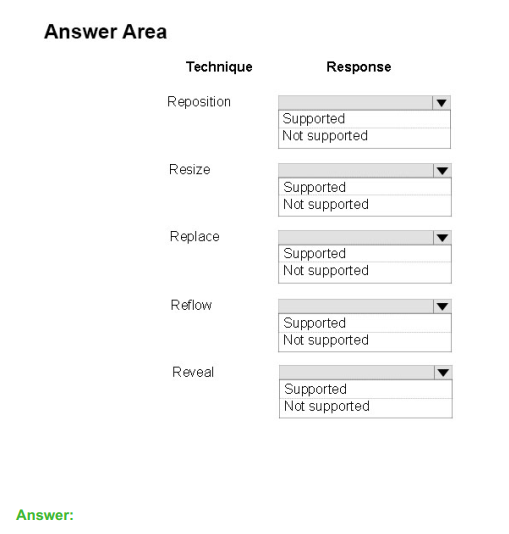
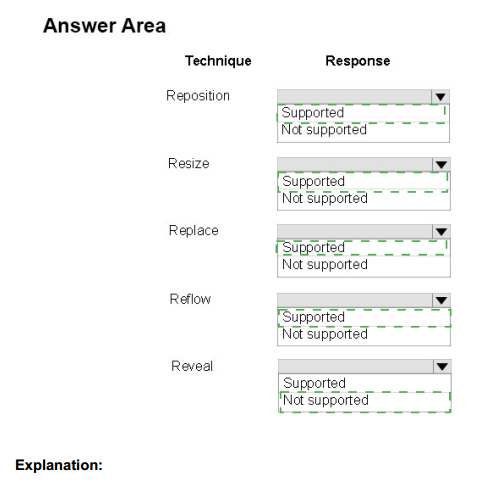
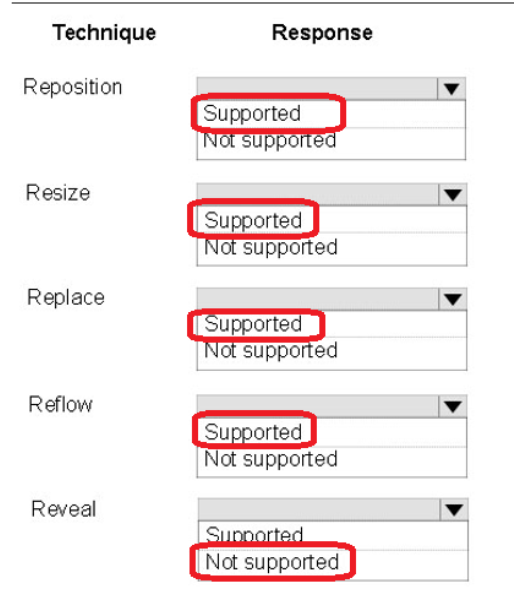
Responsive design techniques
When you optimize your app’s UI for specific screen widths, we say that you’re creating a responsive design. Here are six responsive design techniques you can use to customize your app’s UI.
* Reposition
You can alter the location and position of app UI elements to get the most out of each device
* Resize
You can optimize the frame size by adjusting the margins and size of UI elements.
* Reflow
By changing the flow of UI elements based on device and orientation, your app can offer an optimal display of content-
* Show/hide
You can show or hide UI elements based on screen real estate, or when the device supports additional functionality, specific situations, or preferred screen orientations.
* Replace
This technique lets you switch the user interface for a specific device size-class or orientation. In this example, the nav pane and its compact, transient UI works well for a smaller device, but on a larger device tabs might be a better choice.
* Re-architect
You can collapse or fork the architecture of your app to better target specific devices.
Question No : 17 – (Topic 2)
You are developing a Universal Windows Platform (UWP) app that uses XAML and C#. The app must use the Model-View-ViewModel (MVVM) pattern. The user interface (UI) triggers an event. You need to bind the event to a view model method. What should you do?
A. Create a custom behavior and attach the behavior to the UI element. Bind the behavior’s event trigger to the command declared in the view model.
B. Create an attached property of type ICommand. Bind the UI element’s event to the attached property.
C. Assign the value of the DataContext property to the view model. Use the BindingExression.UpdateSource() method to update the data source.
D. Add a strongly-typed view model property to the view. In the code behind file for the view, invoke the view model method.
70-357 pdf Answer: B
Explanation:
Commands are an implementation of the ICommand interface that is part of the .NET
Framework. This interface is used a lot in MVVM applications.
Question No : 18 – (Topic 2)
You are designing a roadside assistance mobile app. The app displays a persistent list of links to pages. The app displays a persistent list of links to pages. The pages provide a quick way to move between different views of the a pp. You need to recommend a user interface pattern that meets the following requirements:
• Allow users to navigate to frequently accessed, distinct content categories,
• Provide two or more content pones that have corresponding category headers.
• Display the navigation controls on the top of the screen.
• Highlight the currently selected navigation control.
Which pattern should you recommend?
A. hub
B. tabs and pivots
C. active canvas
D. master/details
Answer: B
Explanation:
The Pivot control and related tabs pattern are used for navigating frequently accessed, distinct content categories. Pivots allow for navigation between two or more content panes and relies on text headers to articulate the different sections of content. Tabs are a visual variant of Pivot that use a combination of icons and text or just icons to articulate section content. Tabs are built using the Pivot control.
It is so helpful for you to prepare this high qualified exam. We value the quality of training you receive through our Microsoft MCSD 70-357 practice test. Studying with pass4itsure 70-357 dumps exam questions guarantees your successes at your first attempt. 70-357 braindump sites cannot compare to the understanding, learning and comprehension you will gain from a non 70-357 braindumps site, based on facts and case studies, like pass4itsure. Preparing with Pass4itsure for the 70-357 dumps examination will not just spend less your vitality and assets but time as well, because it has executed all that for you, what you may carry you weeks to achieve.
[New Pass4itsure Microsoft 70-357 PDF Dumps Questions From Google Drive]: https://drive.google.com/open?id=0BwxjZr-ZDwwWQjlza2NZcVR2Z0U
[New Pass4itsure Microsoft MB2-715 PDF Dumps Questions From Google Drive]: https://drive.google.com/open?id=0BwxjZr-ZDwwWakJxSWNCcFlELWs
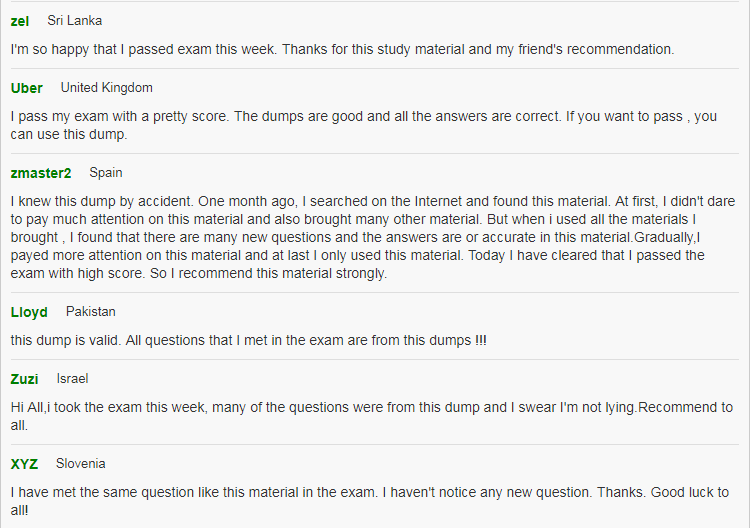
Pass4itsure are committed to providing comprehensive service to the majority of consumers and strive for constructing an integrated service. Passing the 70-357 exam has never been faster or easier, now with actual questions and answers, without the messy Microsoft MCSD 70-357 practice test that are frequently incorrect. Pass4itsure assure you that if you have any question about the 70-357 dumps exam practice vce, you will receive the fastest and precise reply from our staff, please do not hesitate to leave us a message or send us an email.
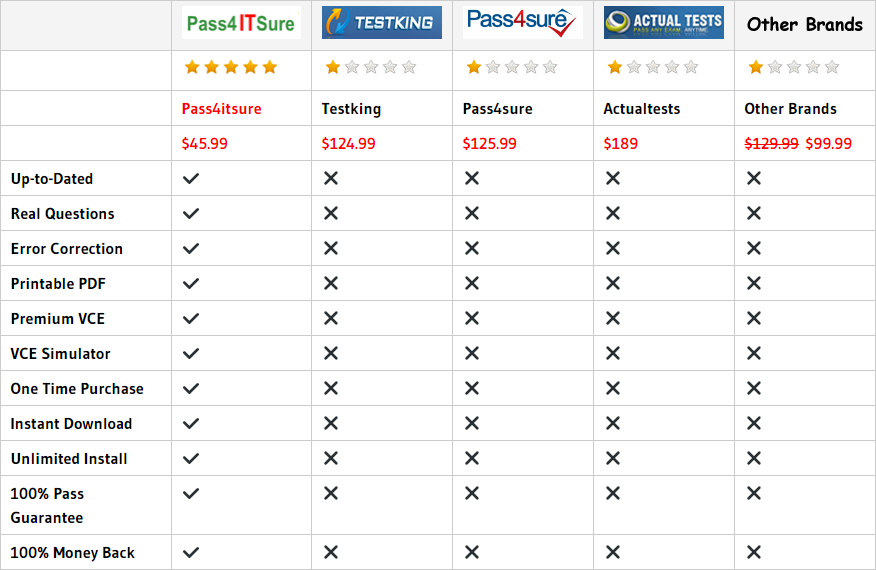
Pass4itsure Microsoft 70-357 Dumps, Useful Microsoft 70-357 Dumps Preparation Materials Latest Version PDF&VCE, We Help You Pass Developing Mobile Apps. Pass4itsure 70-357 Dumps Exam Youtube Free Online Test Here:
Pass4itsure Promo Code 15% Off
